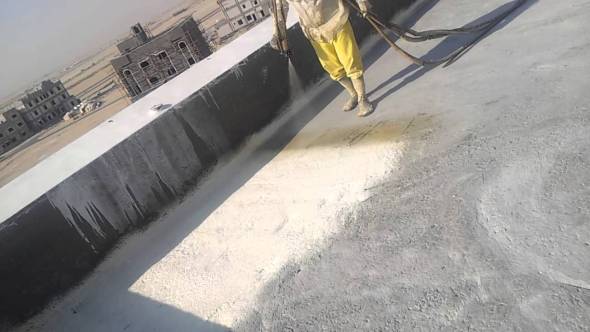Riyadh Thermal Insulation Company 0561164566
Thermal insulation company in Riyadh
Thermal insulation of walls in Riyadh is to prevent or limit the transmission of heat between objects by thermal contact or in the radiative emission range.
Heat transfer is the transfer of heat energy between objects through the difference in temperatures of these bodies, where it is known that heat is considered a form of energy.
The means to stop heat emission is to treat it in several ways that we will mention later, in addition to choosing materials with appropriate heat capacity based on several factors.
Heat flow is mainly the result of bodies contacting each other through temperature differences. Thermal insulation provides a means of maintaining a gradient in temperature, by providing an isolated region in which the heat flow is reduced or heat radiation is reflected rather than absorbed.
In buildings, insulating materials are determined by a measured amount of insulating power called R-value. Thermal engineering scale for insulation systems of furnaces, reactors, furnaces, and thermal conductivity (K), product density and specific heat are the main product characteristics, which affect the thermal insulation efficiency. Low thermal conductivity (K) is similar to high insulating capability (R), and silica and ceramic (fiber insulation) are the best performance insulators for applications between 200 ° C and 2000 ° C. Zirconia fibers have the lowest thermal conductivity of all ceramic fiber products and are used in applications up to 2000 ° C.
Thermal properties of the thermal walls insulation company in Riyadh:
One of the thermal properties of the thermal insulation company in Riyadh is the ability of the material to thermal insulation, and this capacity is usually measured by the thermal conductivity coefficient, the lower the thermal conductivity coefficient the greater the resistance of the material to heat transfer and vice versa, and it is clear that the thermal resistance is inversely proportional to the coefficient of thermal conductivity .
The heat is transferred through the solid insulation by conduction. It is noted that the reflective materials are effective materials in thermal insulation because of their high ability to respond to radiation and heat waves. The ability of these materials to isolate increases with increasing their luster and polishing, and the insulation material is often integrated with the walls and ceilings.
To know the total resistance to heat transfer, it is necessary to collect different resistances of the wall or ceiling layers, including the resistance (permeability) of the air layer adjacent to the inner and outer surfaces. The collection of these resistors is quite similar to the collection of electrical resistors, they are either parallel or consecutive, and this depends on the position of the materials in the wall or ceiling. In addition to the mentioned thermal properties, there are other properties such as specific heat, heat capacity, thermal expansion and diffusion coefficient, which need to be known for each insulating material.
Choosing the appropriate thermal insulation materials:
Among the most important factors that affect the selection of suitable thermal insulation materials are the following:
The insulation material should have a low thermal conductivity factor.
To have a high degree of resistance to penetration of water.
To be highly resistant to water vapor absorption.
To be highly resistant to stresses caused by large temperature differences.
It has good mechanical properties such as high compression resistance coefficient and breakage resistance coefficient.
To be resistant to bacteria, mold and fire, especially in places prone to fire easily.
To be long-term fixed with minimal expansion coefficient.
To be resistant to chemical reactions.
Not to result in any health damages.
Heat insulation materials in Riyadh:
Thermal insulation materials can be divided according to their sources into five sections:
Insulating materials of animal origin: such as animal wool and hair, and their use as insulating materials is limited.
Insulating materials of Jambian origin: Like glass wool, which is one of the best thermal insulation materials.
Industrial insulation materials: include rubber and foamed plastics, the latter being the most common, and the most common type of foam polystyrene is used.
Insulating materials of vegetable origin: It includes fibers and cellulose materials such as reeds, cotton and so on.
Nanotechnology insulation materials: They are liquid materials that are applied to the surface of iron melt furnaces to reduce heat emission from them.
Types of insulation and their uses [edit]
Insulating materials can be found in several forms:
Felt.
Lightly infantile filling granules.
Foaming fluid spray.
Rigid foam (regulations or strips).
Felt
There are on the market in the form of long rolls and various thicknesses, and most felt is coated with paper or metal foil with a frame on both sides to hold the sides, and the metal foil can be on one side of those rolls, and one of the sides can be coated with paper covered with asphalt or bitumen to act as a barrier Steam, moisture, or a layer of fluffy paper punched on the other side.
Felts are often made from organic materials that include glass fibers. It can also provide cellulosic fibers in the form of felt. Felts are placed on the inner wall of the building, and are often used to insulate roofs and walls.
Advantages of using thermal insulation in Riyadh:
Rationalization in the consumption of electrical energy, as scientific experiments have demonstrated that the application of thermal insulation in Riyadh to residential buildings, government, commercial and industrial facilities reduces electrical energy at rates up to 40%. # The building maintains the appropriate temperature for a long time without the need to operate the air conditioners for long periods of time. # It is allowed to use air conditioners with small [[electrical capacity | capabilities]], thus reducing energy consumption costs and the devices used. # Raise the level of comfort for the building's users. # Reduces
2019-12-08
Visits : 1008
Comments
: 0
Share :

